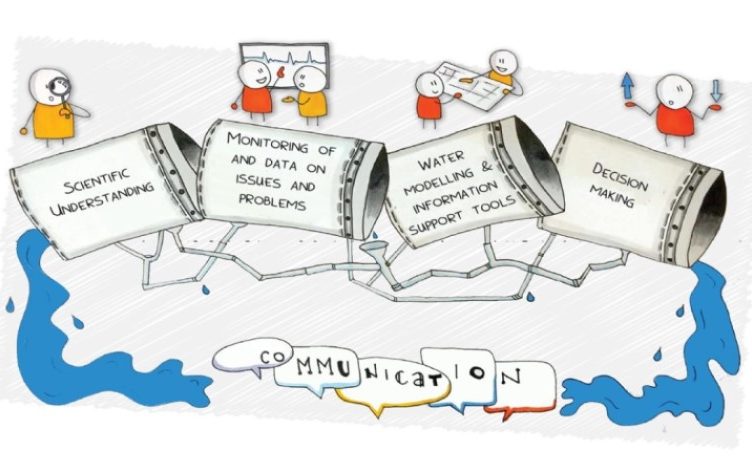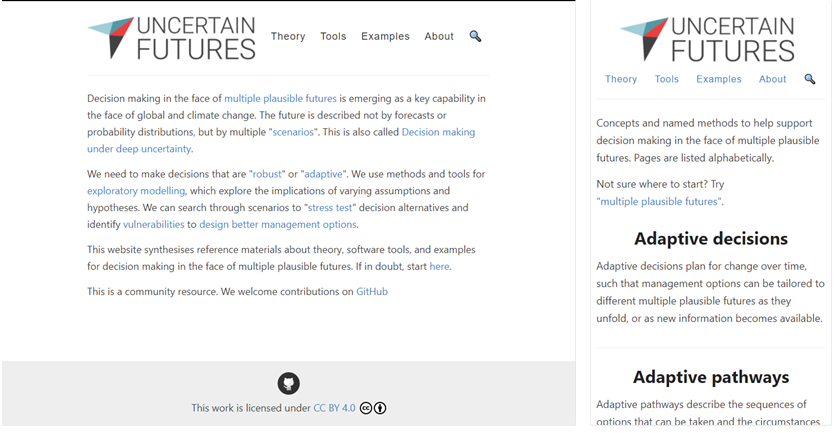
05/12/2024
Event Summary: Overview of water quality modelling projects from the Queensland Water Modelling Network with Callym Dunleavy
Read more
In late 2020 the QWMN Small Grants fund sponsored ANU’s Institute for Water Futures to create a simple but attractive website that synthesises theoretical and case study materials about decision making in the face of multiple plausible futures in a form conducive to the creation of products for training and awareness raising. The collected materials are provided with a Creative Commons Attribution license, explicitly encouraging collaborative development of added value products.
The website can be found here – https://uncertainfutures.github.io/ .
Funds were used to hire a research assistant to synthesise materials and write summary text for the website, and a graphic designer to ensure the website appears attractive and professional. Substantial in-kind support established the website, and continues to provide ongoing support for development and review of materials. Prior to launch, we plan to formalise review processes with input from the QWMN to provide transparency and ensure the relevance and accessibility of the materials provided.
This small project aims to lay the foundations for a longer term endeavour. Hosting the website on the software development and version control website Github provides strong tools for receiving and reviewing new contributions, and the website both explicitly welcomes contributions and provides initial instructions (https://github.com/uncertainfutures/uncertainfutures.github.io/wiki), which are likely to develop further as contributions are received.
As planned, the website follows “design pattern” principles as a pilot case that may be followed in the future for other subjects of interest to the QWMN. The idea of design patterns is still under-explored in modelling, but here consists of certain key elements: decomposing a problem situation into design elements, making links between elements explicit, and encouraging users to mix and match components to form their own understanding of the tools available.
The website provides three types of pages:
The home page provides links directly to several concepts, and index pages for each type of page provide short summaries, also acting as a glossary. The website allows for pages under construction (that only include summaries) in order to ensure that concepts are represented even if full content has not been compiled. Each page for a concept, method or tool, discusses the purpose and requirements, describes what is involved in using it, and provides links to case studies and further resources.
A potential user has five potential entry points from which to explore the reference material provided: 1) links channelling the reader to the page on “multiple plausible futures”, which serves as an introduction to the topic, 2) searching for a known concept, 3) browsing through documented theory pages to come across as something new, 4) browsing through software tools, and 5) browsing through general problems and case studies of interest. Dense interconnection between pages encourages the reader to then follow their nose to learn more detail about interconnected concepts.

This project works towards building capacity for decision making in the face of multiple plausible futures through adoption and adaptation of appropriate decision frameworks in the Queensland Water Modelling Network, both inside and outside government. As a small project, it provides a first step in a longer term effort to ensure that 1) students, consultants and other modellers are trained in these methods, 2) decision makers and policy analysts have a clear understanding of how these methods can be used in their processes, 3) funders require consideration of decision frameworks within projects to ensure the resulting work is decision-relevant and actionable.
The website is already publically available but has not yet been fully launched. Initial feedback, however, has been positive from colleagues not involved in its design: “The website is a great concept – I would definitely use it myself as a resource”, “This would have saved me months to understand the links between theories.”
Ongoing tracking is planned to measure engagement with the website. Contributions and comments will assessed through changes made to Github. Google Analytics will be set up in order to be able to report on site visits. Follow-up marketing through the QWMN will help ensure awareness of the website amongst students, consultants and other modellers, as well as lecturers and training organisations. More broadly, the project could be deemed a success if the materials or derived products are regularly used in discussions about decision making in the face of climate change. Follow-up analyses could seek to quantify mention of keywords within relevant reports and tenders, and assess how well multiple plausible futures have been addressed in decision making processes.
Pending further feedback, the website appears have provided an effective means of organising knowledge, and provide a flexible product that provides a solid foundation to leverage QWMN funding and incorporate contributions from university and industry. The website will also be included as a pilot case in research publications in Dr Guillaume’s DECRA grant. Subject to funding, it also appears likely that similar approach can be applied to other topics of interest to the QWMN to help address the skills and knowledge audit response report beyond the specific focus of this project.
Considering the long term aim of embedding decision frameworks within modelling and decision making processes faced with multiple plausible futures, this small project addresses the first of a four phase process, while establishing foundations to support later phases:
Start collating materials – develop and collate materials and approaches for applicable decision frameworks for water modelling and the likely work flows needed. This forms the basis of products or materials ready to go out to industry.
Develop awareness – present this to enablers and decision makers through the QWMN as part of a framework to embed DMDU approaches in complex modelling (and other) projects and programs. This is to help build the interest in the approaches and look for implementation opportunities, or even just to look at formalising one or two frameworks as case studies or aligning with existing projects.
Build capacity – From the materials collected in the first phase, and depending on the case studies or existing projects, develop and implement a training package around applying decision frameworks to account for deep uncertainty.
Embed Decision Making under Deep Uncertainty (DMDU) approaches – Have a dedicated theme around decision frameworks as part of the QWMN Community of Practice, with regular events, dedicated sessions at the annual forum, and linkages to MODSIM etc.
We look forward to making use of the uncertainfutures website in pursuing these next phases.